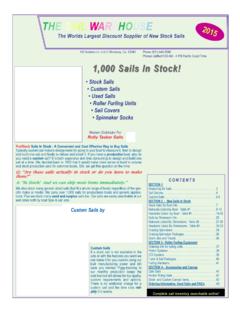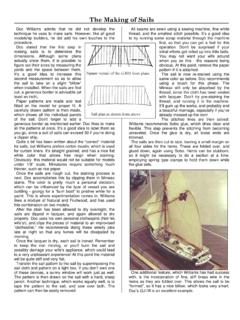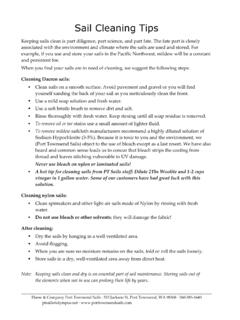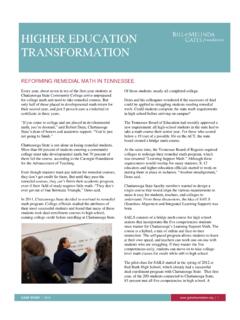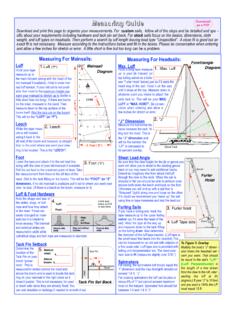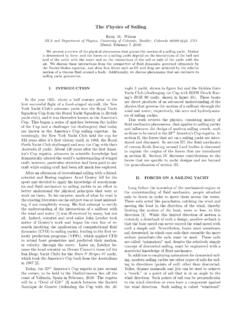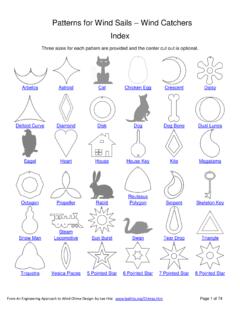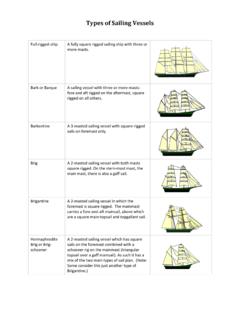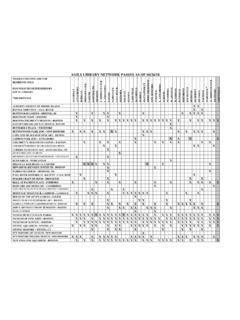Transcription of Setting, Dousing and Furling Sails - Los Angeles Maritime ...
1 24 Setting, Dousing and Furling Sails Organization When at sea the organization for setting and Dousing Sails will be determined by the Captain and the First Mate. With a large and well-trained crew, the crew may be able to be broken into two groups, one for the foremast and one for the mainmast. With small crews, it will become necessary for everyone to know and work all of the lines anywhere on the ship. In any event, particularly if watches are being set, it becomes imperative that everyone have a good understanding of all lines and maneuvers the ship may be asked to perform. Safety Sailing the brigantines safely is our primary goal and the Los Angeles Maritime Institute has an enviable safety record. We should stress, however, that these ships are NOT rides at Disneyland.
2 These are large and powerful sailing vessels and you can be injured, or even killed, if proper procedures are not followed in a safe, orderly, and controlled fashion. As a crewmember you have as much responsibility for the safe running of these vessels as any member of the crew, including the ship s officers. 1. When laying aloft, crewmembers should always climb and descend on the weather side of the shrouds and the bowsprit. Because the ship heels from the pressure of the wind in the Sails the angle is less and the wind helps hold you into the rigging instead of trying to blow you off. 2. When climbing aloft all persons leaving the deck will wear climbing harnesses. There are no exceptions. The perception of risk is very important, even essential, to the sense of adventure and the success of our program.
3 The assurance of safety is essential to the survival of our program and organization. The balancing of these seemingly conflicting needs is one of the most difficult and demanding tasks you will have in working with this program. 25 3. No person may leave the deck to go aloft or out on the bowsprit until they get specific permission from either the Captain or the Mate of the Watch. 4. Once you get into position to work aloft, either on a yard, bowsprit or the cranelines, you should clip the safety harness into either the standing rigging or the safety stays located on the yards. 5. When climbing aloft you should only grasp the shrouds, not the ratlines. The lashings on ratlines can carry away and it s not pleasant to have someone step on your hand. 6. Before laying out on a yard, you should check to make sure the yard is down solidly in its lifts, and that there is no slack in the braces which would allow the yard to swing.
4 7. Before laying onto a footrope or craneline you should announce your intentions to the other crewmembers on the yard or craneline by saying, laying on starboard! (port) . Before stepping on, you should wait for an acknowledgment from the people already on the footrope. You should also warn your shipmates before laying off. 8. All gear taken aloft must be secured to your body or to the ship with lanyards. This includes all tools, knives and marlinespikes, or any other gear that leaves the deck. If you don t need it to work aloft, don t bring it. 9. Always furl all headsails and staysails from the weather side, so that the Sails cannot push you off. 10. Never get on the upper topsail yard to put the sail into its gear or to furl the sail if there are still shipmates on the lower topsail yard.
5 Because these yards are so close together, putting the upper topsail into its gear or casting The adults who work with our kids recognize the differences between training and education and function appropriately. 26 off gaskets could hit people working on the lower yard. 11. When hauling on a line, keep a healthy distance between your hand and any blocks, cleats, or belaying pins. Getting a hand sucked into a block is a good way to lose your fingers. 12. Never cast a line off a cleat or pin unless you are sure what the line is for and until you check to see if the line is under a load. 13. You should not sit or stand on any yards unless you have permission from the ship s officers (Captain and/or Mate). 14. When conducting sail maneuvers, or when setting sail, you should remain as quiet as possible so that commands can be heard and understood.
6 Unnecessary talking or shouting is distracting and can cause injury. 15. Any maneuver can be stopped by anyone at any time by yelling Avast! If you see an action that is in danger of causing an injury, sing out immediately. Setting Sail The traditional order of setting sail is from the largest and lowest on the masts to the smallest and highest. This is generally followed on both masts, with the lower staysails being set before the upper ones. The headsails are usually set from the nearest to the farthest. On the foremast, the first square sail to be set is the lower topsail, followed by the upper topsail, then either the course or topgallant following. As the wind picks up and sail is shortened, the reverse order is followed. The topgallant would be taken in first, along with the upper staysails and the gaff topsail.
7 The upper topsail would follow, then the course and last the lower topsail. When the fore course is taken in, the fore staysail would be set, as this sail will not be set when the course is being used. A good crew, The adults who work with our kids are knowledgable, knows how things work, understands systems, is still learning. 27 provided there are enough hands, can usually set all of the headsails at once. It is up to the captain and the mate to balance the Sails between the masts so that excessive helm is not required to hold course as the Sails are being set or doused. Unfurling Before sail can be set all gaskets have to be removed from the Sails , both aloft and on deck. This is accomplished on the square Sails by the crew laying out on the yard and getting the gaskets off the sail.
8 This is done by crew working on both sides of the yard simultaneously. By tradition, the first person out on the yard on the weather side is in charge of that yard. You will take your commands from him. On laying out on the yard all gaskets should be cast off and allowed to hang vertically from the back side of the yard. As the gaskets are being taken off, the sail should be held on top of the yard until all of the gaskets are off. When this has been accomplished the person in command of the yard will enquire if everyone is ready. When they are ready he will say Let fall . At that time you will push the sail off the yard so that it is hanging in its gear . After the sail is put in its gear, then all gaskets should be coiled and hung over the front of the yard.
9 It s the responsibility of the yard captain to make sure all gaskets are coiled properly before laying off the yard. In light winds taking the gaskets off the square Sails can be accomplished easily by one person on each side of the yard. In higher winds, more people will be required to prevent the sail from ballooning out before all of the gaskets can be cast off. If this happens, a gasket can get jammed which could damage the sail and which could require that the gasket be cut to unfoul it. All Sails are set and doused from the deck, once unfurling is completed. The adults who work with our kids are passionate about life, alert, careful, optimistic and adventurous. 28 Setting Square Sails Square Sails are set by pulling the clews of the sail down from the yardarms by use of the sheets.
10 This is called sheeting home . Since the clewlines oppose the sheets, they have to be slacked off their pins before the sheets can be pulled. Likewise the buntlines and leechlines are also cast off before the sheets can be hauled. On the fore course, both tacks and sheets have to be pulled on to set the sail. When the fore yard is braced any where other than square the forward clew, the one on the weather side, is hauled forward by its tack. It will be seen that the weather tack and the leeward sheet will have all of the strain on the sail. When the yard is braced square, both sheets will be handling the strain, while both tacks will have little force on them. Because of the size of the fore course, in any kind of wind a lot of muscle is required to pull down the weather tack and the leeward sheet.

